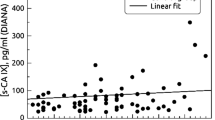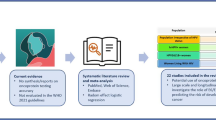Abstract
The factors that determine progression of cervical intraepithelial neoplasia (CIN) to squamous cell carcinoma (SCC) are unknown. Cigarette smoking is an independent risk factor for cervical neoplasia, suggesting that polymorphism at detoxicating enzyme loci such as cytochrome P450 CYP2D6 and glutathione S-transferase GSTM1 may determine susceptibility to these cancers. We have studied the frequencies of genotypes at these loci in women suffering low-grade CIN, high-grade CIN and SCC. A non-cancer control group was provided by women with normal cervical histology suffering menorrhagia. Comparison of the frequency distributions of the CYP2D6 PM, HET and EM genotypes (G-->A transition at intron 3/exon 4 and base pair deletion in exon 5) revealed no significant differences between the menorrhagia and SCC groups. Frequency distributions in the menorrhagia group, however, were significantly different (P < 0.04) from those in the low- and high-grade CIN groups. Thus, the proportion of EM was significantly larger (P < 0.03) and of HET generally lower. We found that the frequency of GSTM1 null in the menorrhagia and case groups was not significantly different. Interactive effects of enzyme genotypes with cigarette smoking were studied by comparing the multinomial frequency distributions of CYP2D6 EM/GSTM1 null/smoking over mutually exclusive categories. These showed no significant differences between the menorrhagia group and SCC or low-grade CIN groups. The frequency distribution in high-grade CIN, however, was significantly different to that in the menorrhagia group and in both SCC and low-grade CIN groups. This study was identified, for the first time, an inherited characteristic in women with high-grade CIN who appear to be at reduced risk of SCC. Thus, women with CYP2D6 EM who smoke have increased susceptibility to high-grade CIN but are less likely to progress to SCC, possibly because they effectively detoxify an unidentified chemical involved in mediating disease progression.
This is a preview of subscription content, access via your institution
Access options
Subscribe to this journal
Receive 24 print issues and online access
$259.00 per year
only $10.79 per issue
Buy this article
- Purchase on Springer Link
- Instant access to full article PDF
Prices may be subject to local taxes which are calculated during checkout
Similar content being viewed by others
Author information
Authors and Affiliations
Rights and permissions
About this article
Cite this article
Warwick, A., Redman, C., Jones, P. et al. Progression of cervical intraepithelial neoplasia to cervical cancer: interactions of cytochrome P450 CYP2D6 EM and glutathione s-transferase GSTM1 null genotypes and cigarette smoking. Br J Cancer 70, 704–708 (1994). https://doi.org/10.1038/bjc.1994.378
Issue Date:
DOI: https://doi.org/10.1038/bjc.1994.378



